Enhancing Cutting Rates in Multi-Channel HSWEDM of Metal Materials with a Novel Decoupling Circuit
Abstract
:1. Introduction
2. Analysis of Multi-Channel HSWEDM Processing
2.1. Electrical Model Analysis of Four-Channel HSWEDM
2.2. Processing Analysis with a Conventional Power Supply
2.3. The Design of the Decoupling Circuit for Multi-Channel HSWEDM
3. Experimental Procedures for Multi-Channel HSWEDM
4. Results and Discussion
4.1. Analysis of Gap Voltage
4.2. Analysis of Discharge Ratio
4.3. Analysis of Cutting Rate
5. Conclusions
- A multi-channel HSWEDM machine tool was designed and manufactured, providing a realistic physical model for studying the multi-channel discharge mechanism in WEDM.
- Through establishing the equivalent circuit, processing model, and synchronized acquisition of discharge waveforms for multi-channel HSWEDM, the study clarified that the equipotential between electrodes in different channels is the main factor responsible for electrical signal coupling between channels. This electrical signal coupling hampers multi-channel synchronous discharge, thereby posing challenges in enhancing cutting rate.
- An MOP power supply was designed. By incorporating a specifically designed limiting resistor Rc, the degree of electrical signal coupling between channels was significantly reduced. Smaller Rc values resulted in a lower degree of coupling, a higher gap voltage, and a higher discharge ratio. In the case of two-channel HSWEDM, the discharge ratio increased from 0.984 at 15 Ω to 1.608 at 5/3 Ω.
- The experimental results demonstrate that the use of an MOP power supply significantly enhances the processing performance of multi-channel HSWEDM. The discharge ratio increased from 0.843 in single-channel HSWEDM to 3.026 in four-channel HSWEDM. Compared to single-channel HSWEDM, the cutting rates of two-channel and four-channel HSWEDM are increased by 84.06% and 247.83%, respectively.
Author Contributions
Funding
Data Availability Statement
Conflicts of Interest
References
- Gao, Q.; Li, Z.; Zhang, Y.; Xi, X.; Yang, F.; Zhao, W. Research on a two-stage discharge current regulation method in RT-WEDM. Int. J. Adv. Manuf. Technol. 2022, 123, 3285–3299. [Google Scholar] [CrossRef]
- Karthikeyan, A.G.; Kalaiselvan, K.; Muralidharan, N. CNC wire-cut EDM input variables analysis on Ni -based superalloy (MONEL K-500). Mater Manuf. Process. 2022, 37, 1035–1044. [Google Scholar] [CrossRef]
- Wang, J.; Sánchez, J.A.; Izquierdo, B.; Ayesta, I. Experimental and Numerical Study of Crater Volume in Wire Electrical Discharge Machining. Materials 2020, 13, 577. [Google Scholar] [CrossRef] [PubMed]
- Murali, G.; Murugan, M.; Arunkumar, K.; Elumalai, P.V.; Mohanraj, D.; Prabhakar, S. Investigation and Process Parameter Optimization on Wire Electric Discharge Machining of Aluminium 6082 Alloy. Adv. Mater. Sci. Eng. 2022, 2022, 1–16. [Google Scholar] [CrossRef]
- Yue, X.; Yang, X. The role of discharge plasma on molten pool dynamics in EDM. J. Mater. Process Tech. 2021, 293, 117092. [Google Scholar] [CrossRef]
- Chen, Z.; Zhang, Y.; Zhang, G.; Huang, Y.; Liu, C. Theoretical and experimental study of magnetic-assisted finish cutting ferromagnetic material in WEDM. Int. J. Mach. Tools Manuf. 2017, 123, 36–47. [Google Scholar] [CrossRef]
- Sibalija, T.V.; Kumar, S.; Patel, G.C.M.; Jagadish. A soft computing-based study on WEDM optimization in processing Inconel 625. Neural. Comput. Appl. 2021, 33, 11985–12006. [Google Scholar] [CrossRef]
- Wang, Y.; Li, Z.; Yao, S.; Wu, C. Analysis of discharge channel characteristics based on plasma flow and heat transfer in USV-MF complex assisted WEDM-LS. Int. J. Heat. Mass. Tran. 2020, 150, 119268. [Google Scholar] [CrossRef]
- Okamoto, Y.; Kimura, Y.; Okada, A.; Uno, Y.; Ohya, J.; Yamauchi, T. Challenge to Development of Functional Multi-Wire EDM Slicing Method Using Wire Electrode with Track-Shaped Section. Key Eng. Mater. 2012, 523–524, 287–292. [Google Scholar] [CrossRef]
- Itokazu, A.; Hashimoto, T.; Fukushima, K.; Yuzawa, T.; Sato, T. Multi-Wire Electrical Discharge Slicing for Silicon Carbide. Mater. Sci. Forum 2013, 740–742, 841–842. [Google Scholar] [CrossRef]
- Itokazu, A.; Miyake, H.; Hashimoto, T.; Fukushima, K. Multi-Wire Electrical Discharge Slicing for Silicon Carbide Part 2: Improvement on Manufacturing Wafers by Forty-Wire EDS. Mater. Sci. Forum 2014, 778–780, 763–766. [Google Scholar] [CrossRef]
- Chen, H.; Liu, Z.; Huang, S.; Pan, H.; Qiu, M. Study of the mechanism of multi-channel discharge in semiconductor processing by WEDM. Mat. Sci. Semicon Proc. 2015, 32, 125–130. [Google Scholar] [CrossRef]
- Pan, H.; Liu, Z.; Qiu, M.; Zhang, M.; Deng, C. Extreme wire electrical discharge machining based on semiconductor characteristics. Int. J. Adv. Manuf. Technol. 2021, 115, 2477–2489. [Google Scholar] [CrossRef]
- Kunieda, M.; Muto, H. Development of Multi-Spark EDM. CIRP Ann. 2000, 49, 119–122. [Google Scholar] [CrossRef]
- Yu, X.; Qiu, M.; Fu, J.; Kong, L.; Han, Y. Multi-channel aerosol dielectric electrical discharge machining ablation based on discrete electrode. Int. J. Adv. Manuf. Technol. 2018, 99, 1037–1045. [Google Scholar] [CrossRef]
- Yang, X.; Yang, K.; Liu, Y.; Wang, L. Study on Characteristic of Multi-spark EDM Method by Using Capacity Coupling. Procedia CIRP 2016, 42, 40–45. [Google Scholar] [CrossRef]
- Yan, M.; Liu, Y. Design, analysis and experimental study of a high-frequency power supply for finish cut of wire-EDM. Int. J. Mach. Tools Manuf. 2009, 49, 793–796. [Google Scholar] [CrossRef]
- Deng, G.; Guo, Y.; Lu, Z.; Bai, J. A Novel Pulse Power Supply for Insulated Ceramics by HS-WEDM. In Proceedings of the Asia-Pacific Power and Energy Engineering Conference, Wuhan, China, 28–31 March 2009. [Google Scholar] [CrossRef]
- Kane, M.M.; Khadse, A.; Chandwani, H.; Bahirat, H.; Kulkarni, S.V. Modeling and Efficiency Improvement of a Pulse Generator for Wire Electric Discharge Machining. IEEE Trans. Plasma Sci. 2020, 48, 3350–3357. [Google Scholar] [CrossRef]
- Yang, F.; Yang, J.; Yao, K.; Hua, H. Adaptive Voltage Position Control for Pulse Power Supply in Electrical Discharge Machining. IEEE Trans. Ind. Electron. 2019, 66, 5895–5906. [Google Scholar] [CrossRef]
- Li, G.; Natsu, W.; Yu, Z. Elucidation of the mechanism of the deteriorating interelectrode environment in micro EDM drilling. Int. J. Mach. Tools Manuf. 2021, 167, 103747. [Google Scholar] [CrossRef]
- Zhou, M.; Mu, X.; He, L.; Ye, Q. Improving EDM performance by adapting gap servo-voltage to machining state. J. Manuf. Process 2019, 37, 101–113. [Google Scholar] [CrossRef]
- Oßwald, K.; Lochmahr, I.; Schulze, H.; Kröning, O. Automated Analysis of Pulse Types in High Speed Wire EDM. Procedia CIRP 2018, 68, 796–801. [Google Scholar] [CrossRef]
- Fan, Y.; Bai, J. Study on volt-ampere characteristics of spark discharge for transistor resistor pulse power of EDM. Int. J. Adv. Manuf. Technol. 2018, 96, 3019–3031. [Google Scholar] [CrossRef]
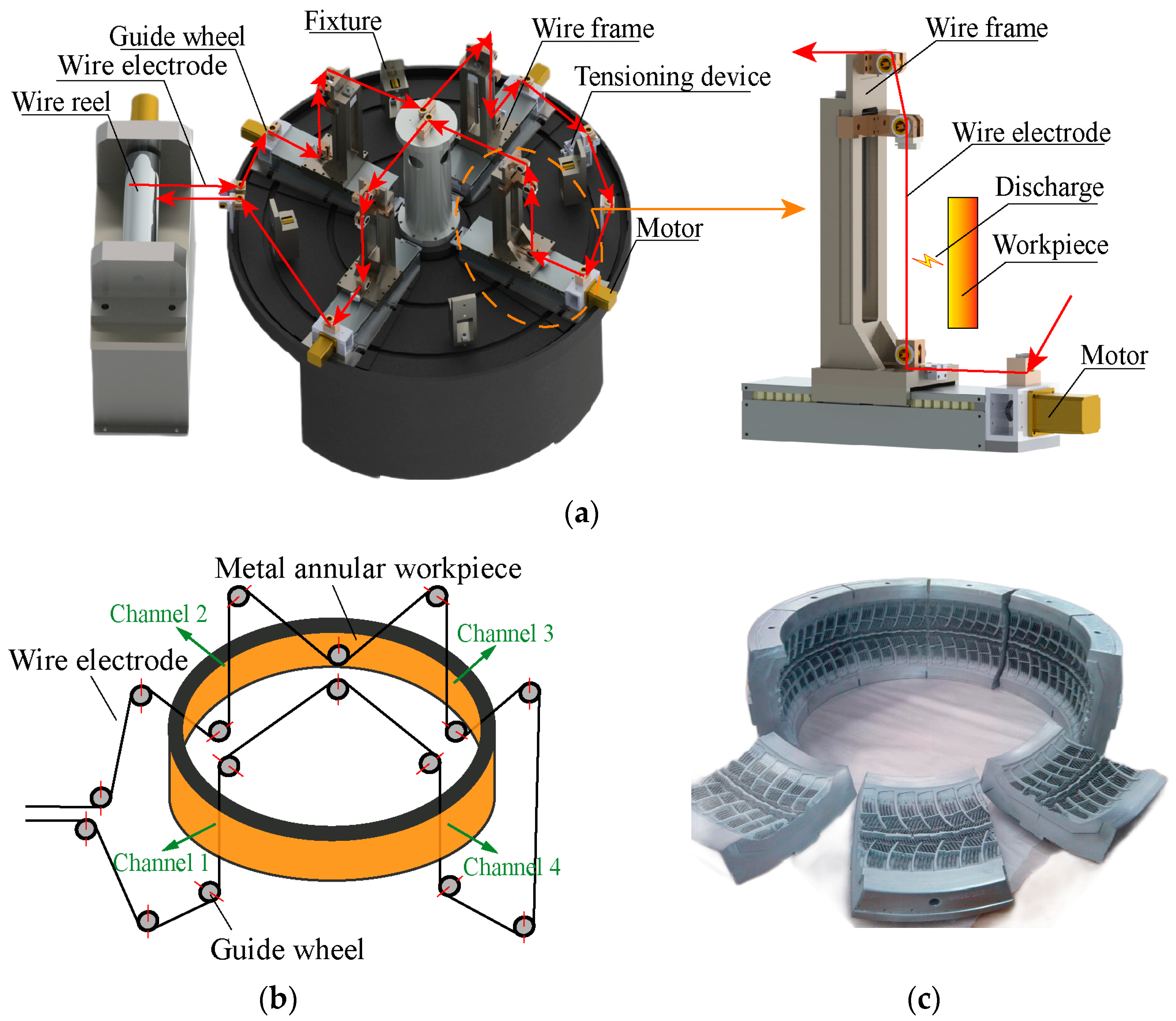
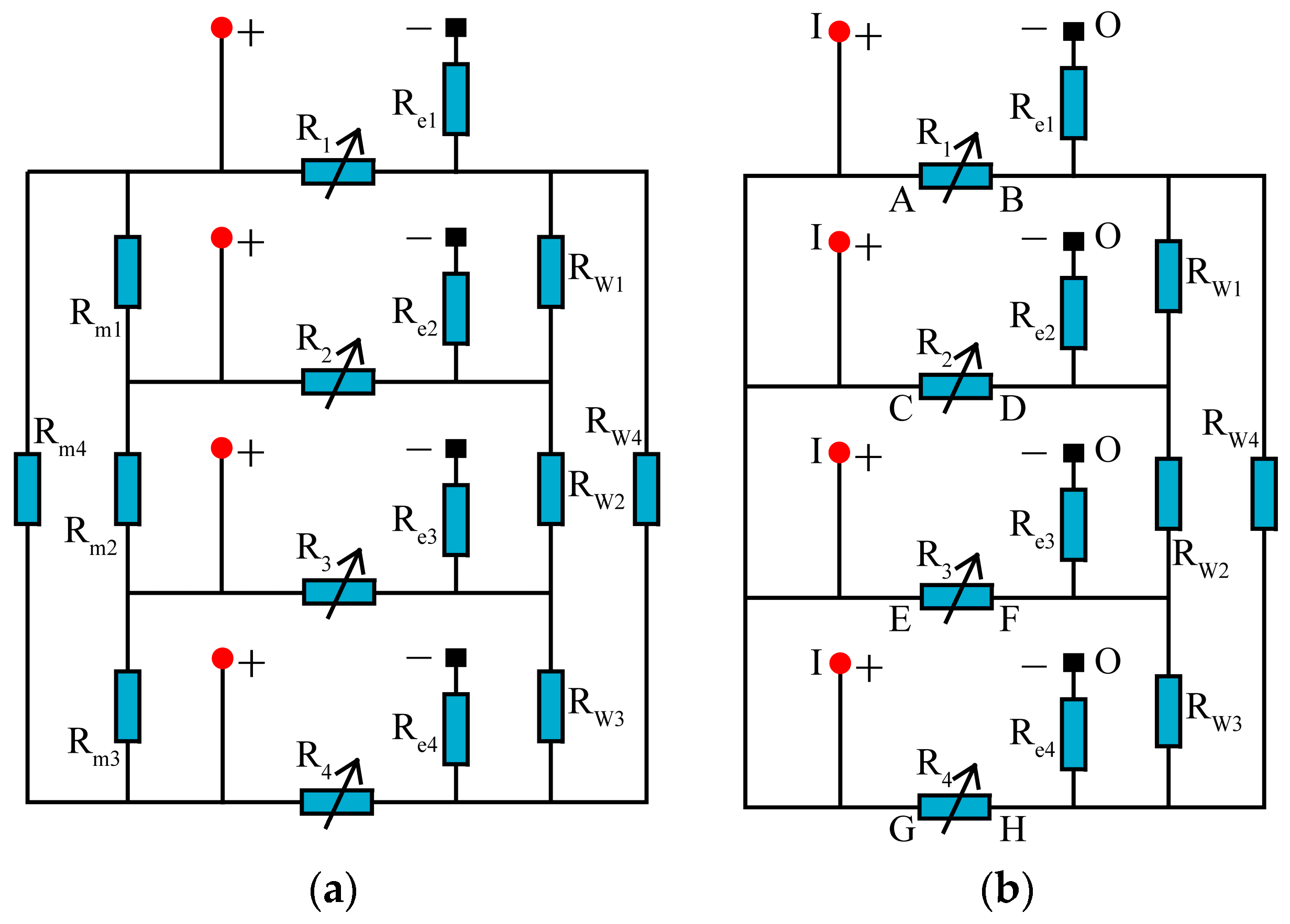
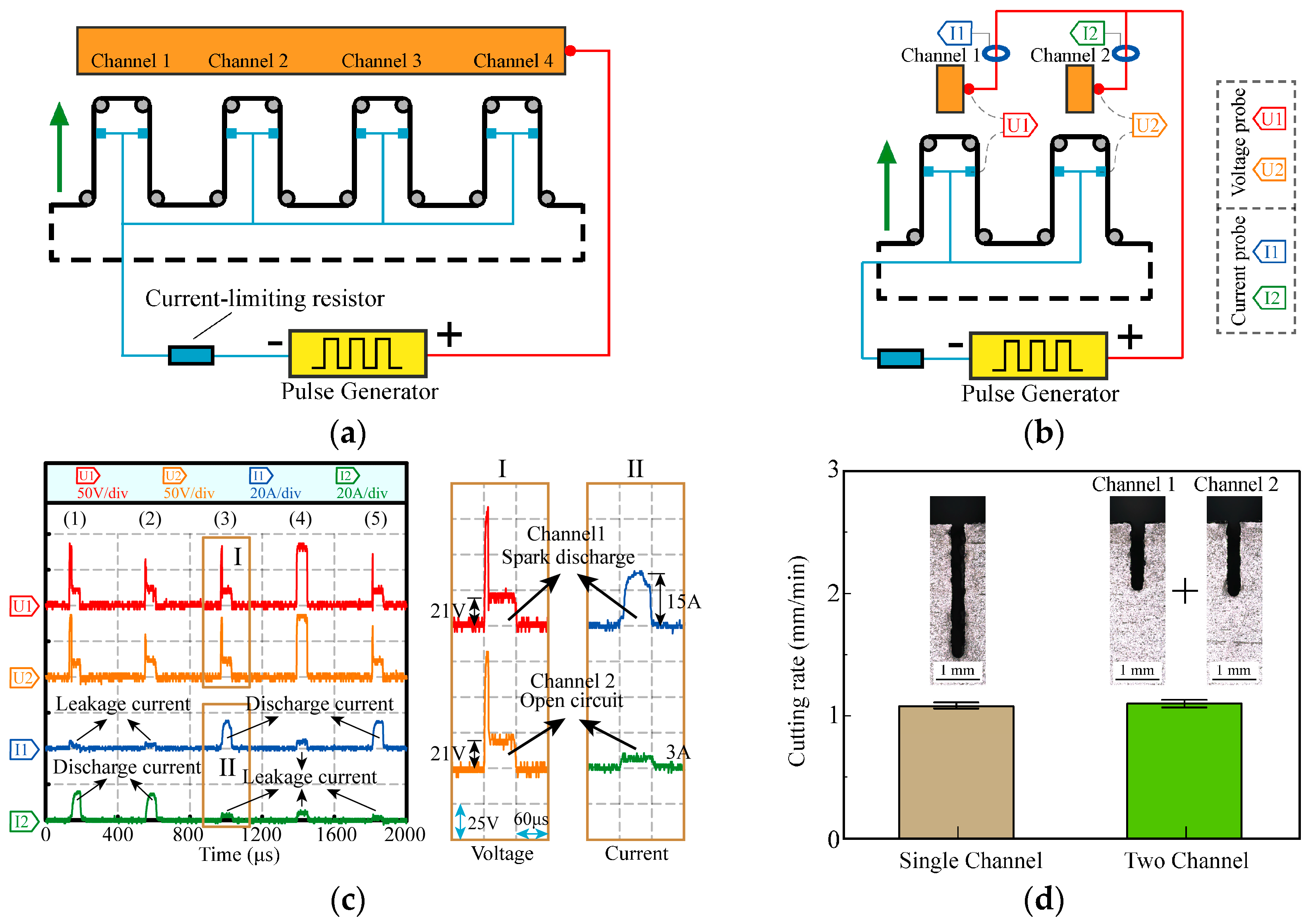
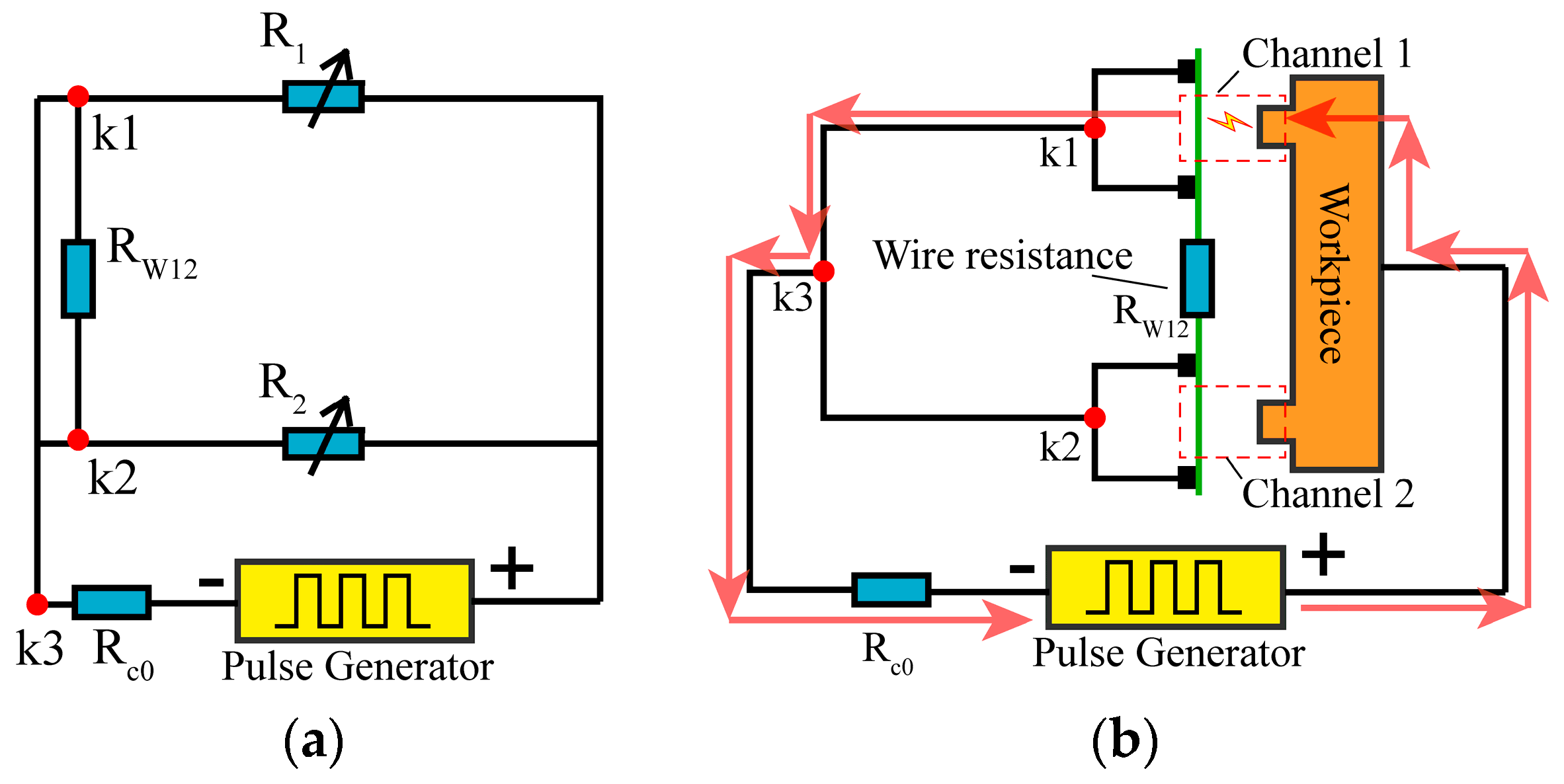
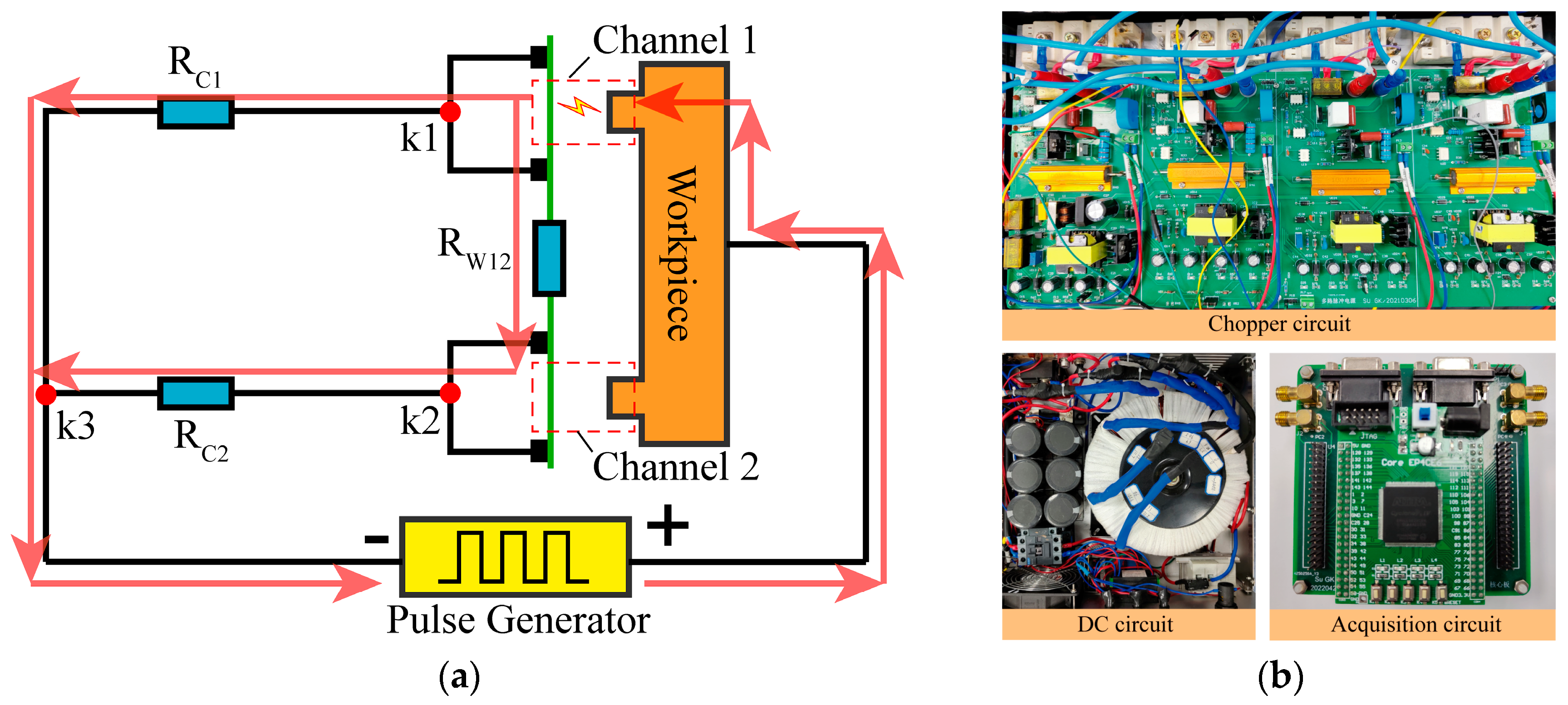
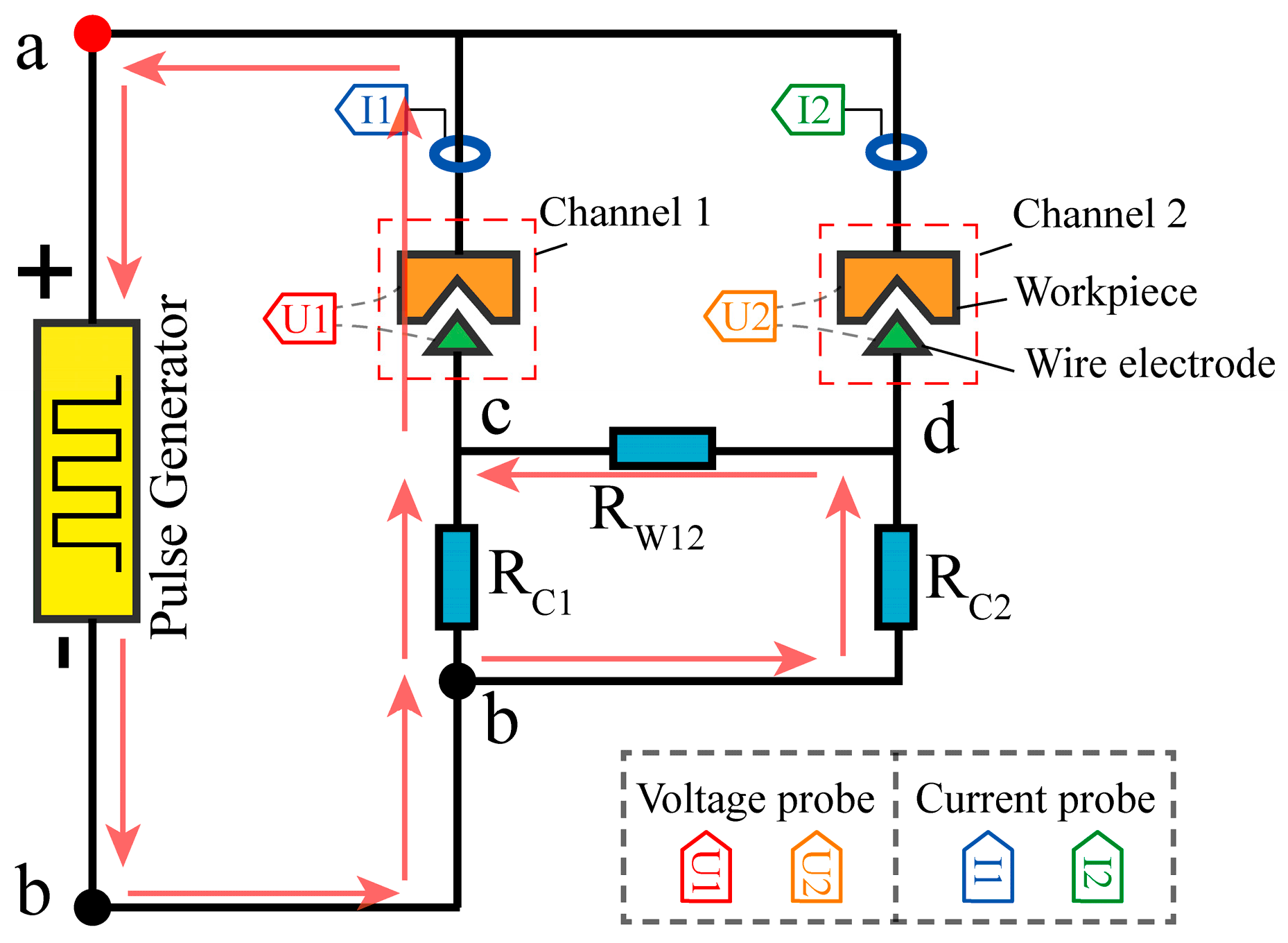
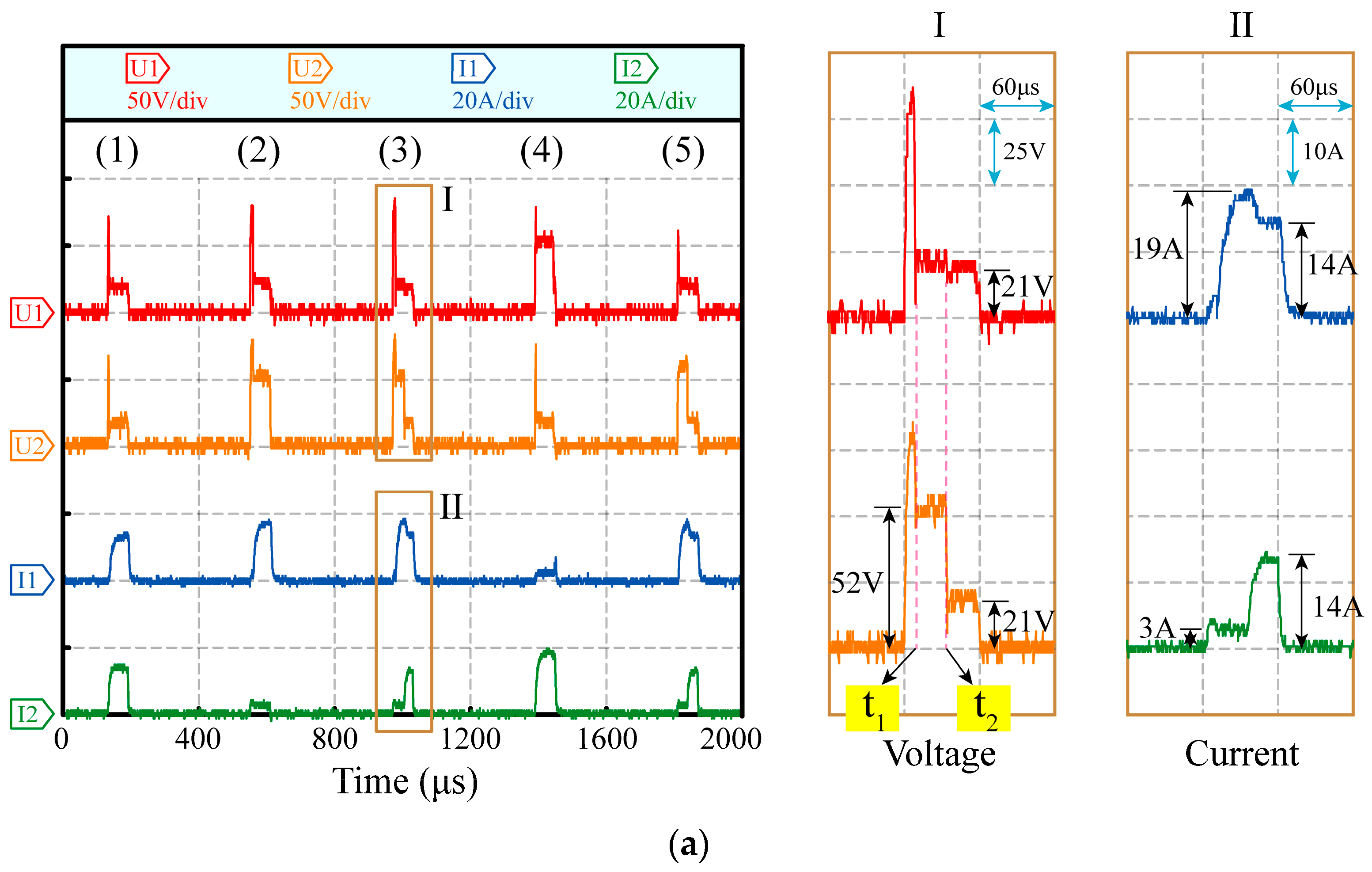
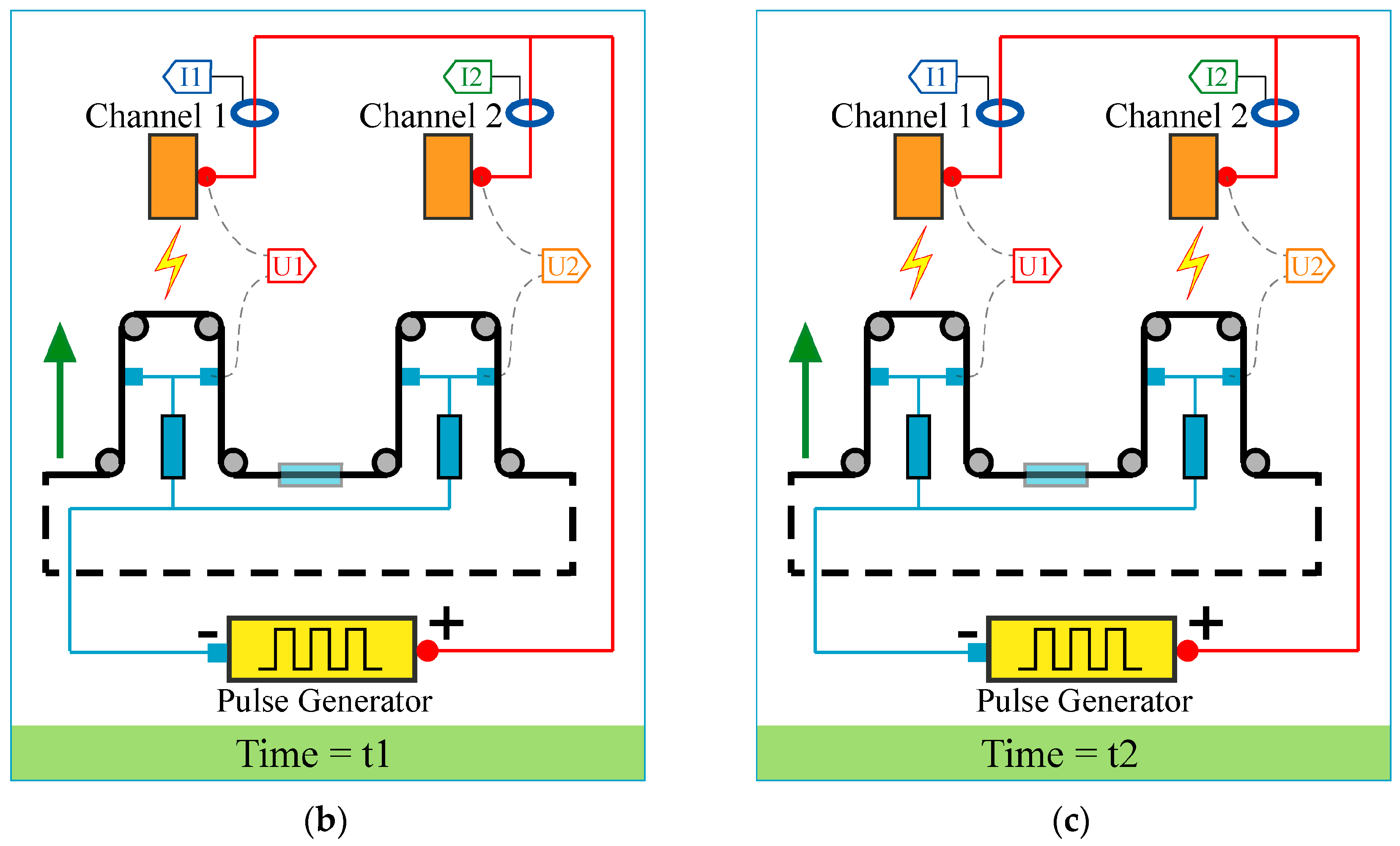

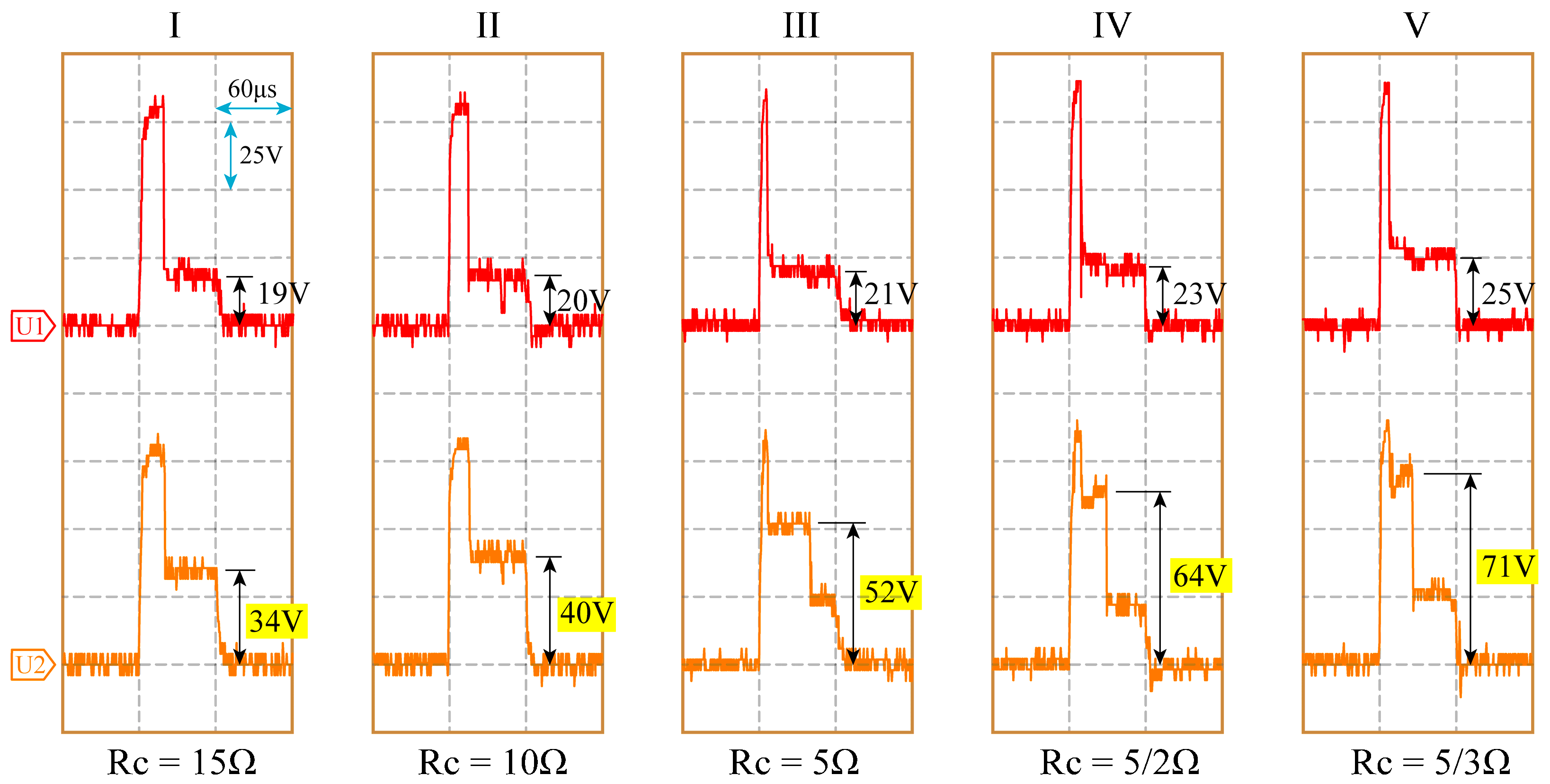
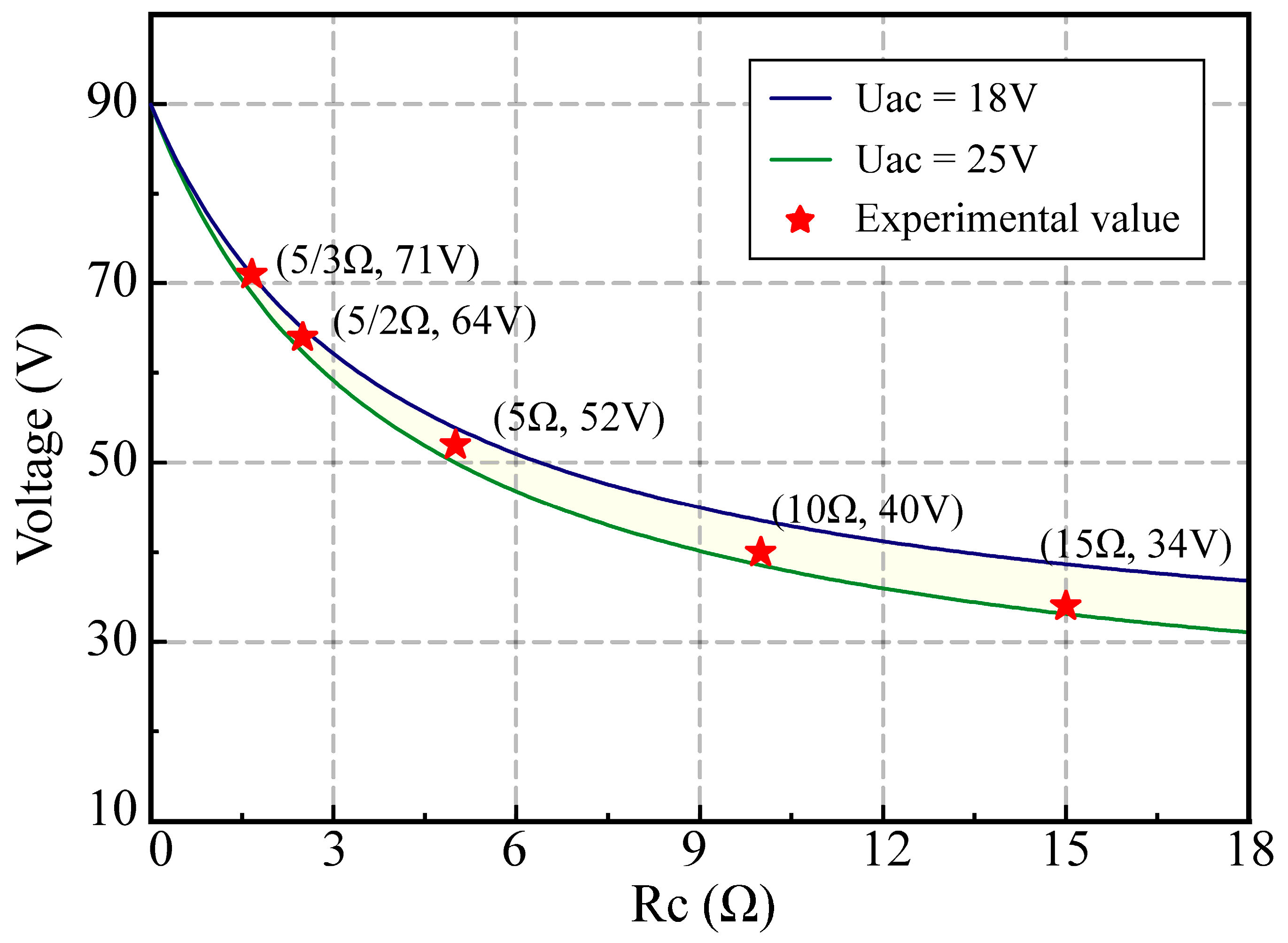
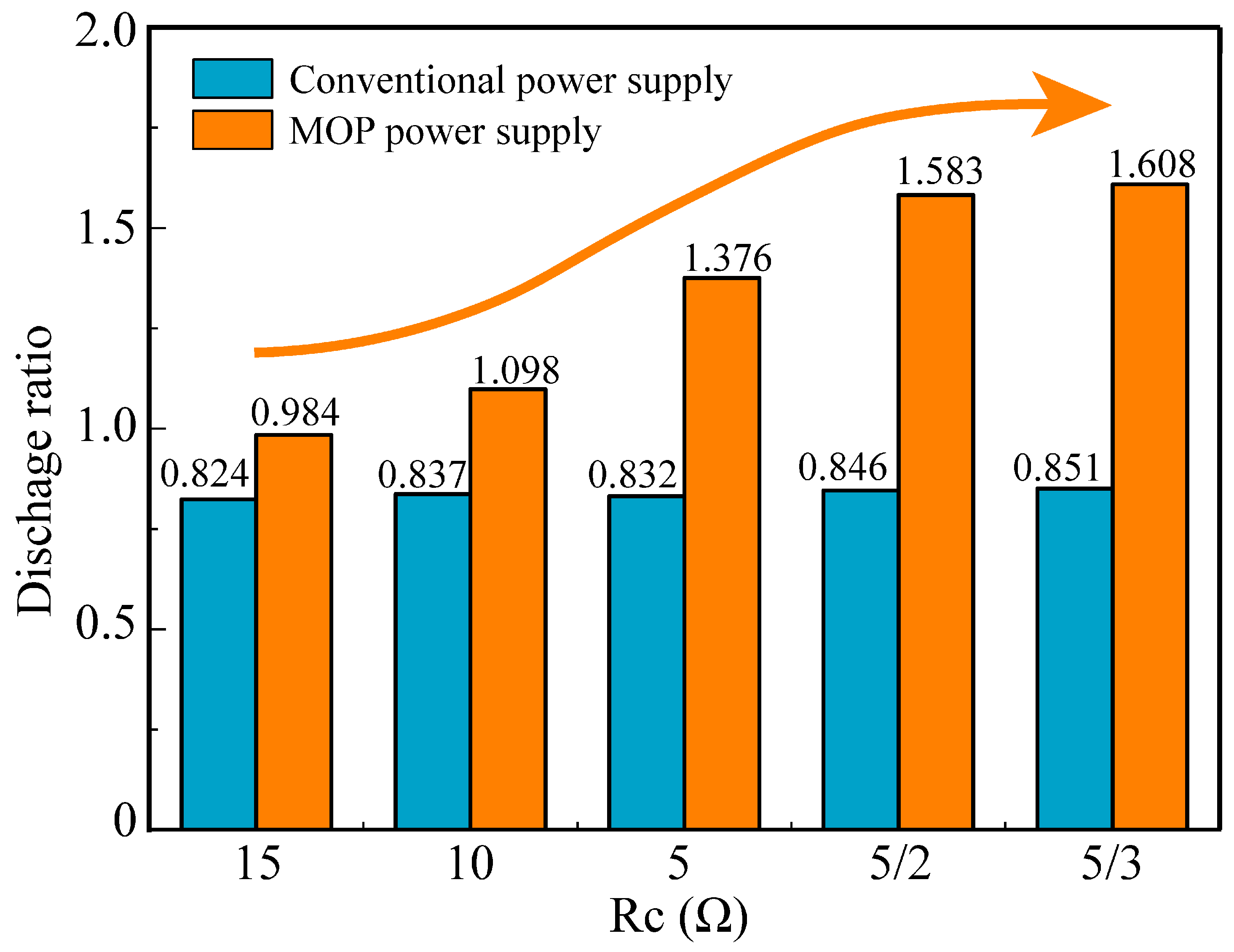

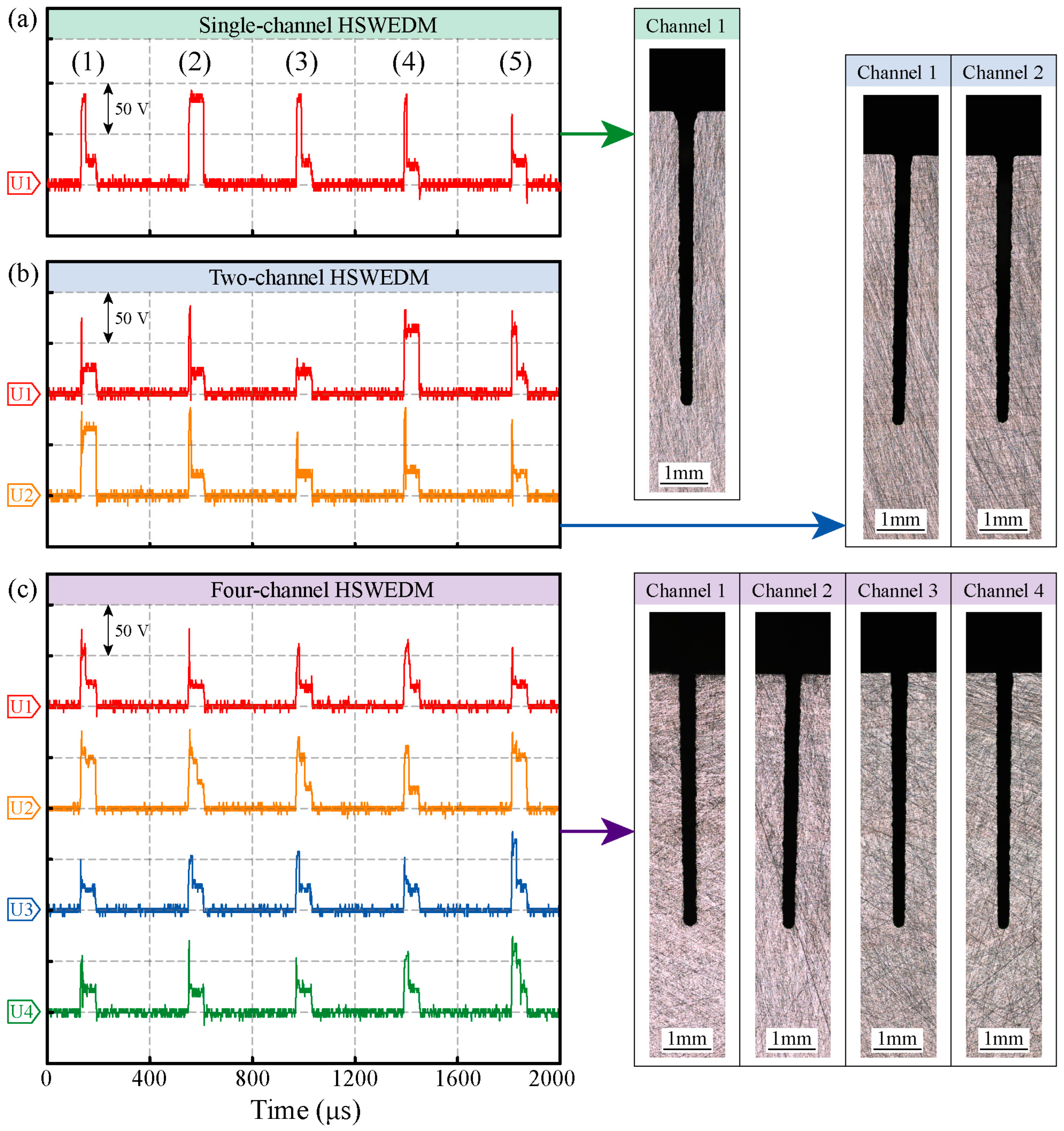
| Parameter | Value |
|---|---|
| Workpiece | ASTM1045 steel, cutting height of 30 mm |
| Diameter of tool electrode | Molybdenum wire, 0.18 mm |
| Working medium | BM-2 water-based fluid, conductivity of 3500 μS/cm |
| Power supply | MOP power supply/Conventional power supply |
| Open voltage | 90 V |
| Pulse width | 60 μs |
| Duty cycle | 1/7 |
| Current-limiting resistance | 15 Ω,10 Ω, 5 Ω, 5/2 Ω, 5/3 Ω |
| Wire speed | 8 m/s |
| Processing time | 3 min |
Disclaimer/Publisher’s Note: The statements, opinions and data contained in all publications are solely those of the individual author(s) and contributor(s) and not of MDPI and/or the editor(s). MDPI and/or the editor(s) disclaim responsibility for any injury to people or property resulting from any ideas, methods, instructions or products referred to in the content. |
© 2023 by the authors. Licensee MDPI, Basel, Switzerland. This article is an open access article distributed under the terms and conditions of the Creative Commons Attribution (CC BY) license (https://creativecommons.org/licenses/by/4.0/).
Share and Cite
Su, G.; Zhang, C.; Li, J.; Liu, G.; Chen, X.; Zhang, Y. Enhancing Cutting Rates in Multi-Channel HSWEDM of Metal Materials with a Novel Decoupling Circuit. Micromachines 2023, 14, 2226. https://doi.org/10.3390/mi14122226
Su G, Zhang C, Li J, Liu G, Chen X, Zhang Y. Enhancing Cutting Rates in Multi-Channel HSWEDM of Metal Materials with a Novel Decoupling Circuit. Micromachines. 2023; 14(12):2226. https://doi.org/10.3390/mi14122226
Chicago/Turabian StyleSu, Guokang, Chuanyun Zhang, Junfei Li, Guixian Liu, Xiaolei Chen, and Yongjun Zhang. 2023. "Enhancing Cutting Rates in Multi-Channel HSWEDM of Metal Materials with a Novel Decoupling Circuit" Micromachines 14, no. 12: 2226. https://doi.org/10.3390/mi14122226
APA StyleSu, G., Zhang, C., Li, J., Liu, G., Chen, X., & Zhang, Y. (2023). Enhancing Cutting Rates in Multi-Channel HSWEDM of Metal Materials with a Novel Decoupling Circuit. Micromachines, 14(12), 2226. https://doi.org/10.3390/mi14122226






